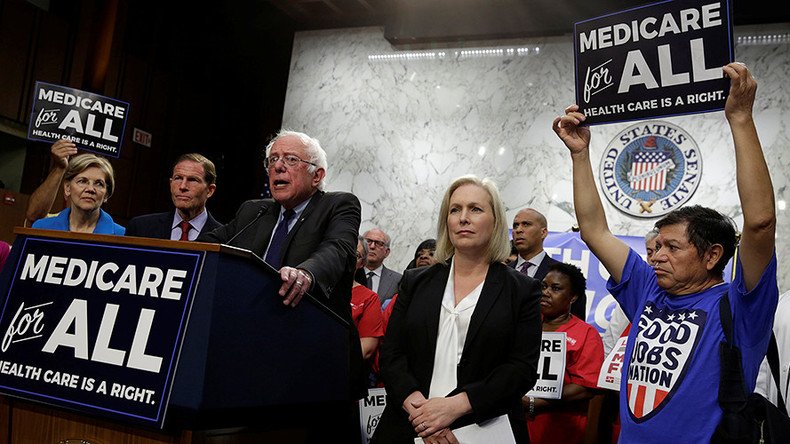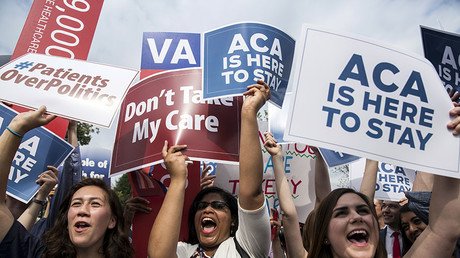Bernie Sanders introduces ‘Medicare for all’ single-payer healthcare reform

Fifteen Senate Democrats are now backing a single-payer healthcare plan which would expand Medicare coverage into a universal health insurance program for all Americans. Senator Bernie Sanders (I-Vermont) introduced the Medicare for All Act on Wednesday.
In a social media post, Sanders noted that 28 million Americans are still without health insurance, and took a swipe at Congressional Republicans for attempting to repeal the Affordable Care Act, also known as Obamacare, earlier this year.
"Our idea is to do what every other major country on earth is doing, and that is to guarantee health care to all people as a right, not a privilege," Sanders said. "I know that taking on the health insurance companies and Wall Street and the drug companies and medical equipment suppliers, all those people who profit off our dysfunctional healthcare system is not going to be an easy fit. The only way we win this is when the American people stand up, as they are, and demand real change."
I'm very proud to be introducing the Medicare for All Act today, which has 15 co-sponsors in the Senate, a record level of support. pic.twitter.com/26GimpDJoC
— Bernie Sanders (@SenSanders) September 13, 2017
If passed, the Medicare for All Act of 2017 would replace the current healthcare system with a public system paid for by higher taxes, covering everything from hospital stays, doctor visits, mental health program, dental, vision and reproductive care, including abortion.
Employers would pay higher taxes, but would longer have to cover insurance for workers, and there would still be private insurers for people who wanted elective treatments like plastic surgery. Doctors would be reimbursed by the government. Consumers may have to pay up to $250 out-of-pocket for prescription drugs, with incentives to use generic medications.
The bill calls for elimination of premiums for private health insurance, deductibles and co-pays.
Long-term care would not be included in bill but covered by separate legislation, an adviser to Sanders told CNN.
Sanders’ proposal is a “horrible idea,” White House press secretary Sarah Huckabee Sanders (no relation to the senator) told reporters on Wednesday afternoon.
“I'm pretty sure that not only does the president not support it, America does not support it or Bernie Sanders would be sitting in the Oval Office right now,” she added.
Sanders campaigned on single-payer in 2016, vying for the Democratic presidential nomination against Hillary Clinton.
“He didn't make it through the primary, he didn't make it into the Oval [Office],” the White House spokeswoman said. “I think that's a pretty clear indication of what Americans want to see and it's not single-payer."
On the campaign trail, Sanders pitched a version of the bill with an estimated price tag of nearly $1.4 trillion, to be paid for in part by a proposed new 2.2 percent income tax on all Americans, a 6.2 percent levy on employers and further round of tax hikes on the wealthy.
Americans would be fine with paying more taxes in exchange for no longer having to fight with healthcare companies, Sanders told the Washington Post.
Sen. Bernie Sanders unveils a single-payer health-care bill. Watch it live. https://t.co/JlegQ8yBANhttps://t.co/lCb7DcFCUT
— Washington Post (@washingtonpost) September 13, 2017
One of the tricky parts of the plan is how to transition from the current system which depends on employer-sponsored private plants, without creating a disruption in care. The plan is to roll it out over a four-year transition process.
In its first year Medicare would lower the eligibility age to 55. Children under 18 would be offered immediate access to the government-run plan. Over the next two years, Medicare enrollment would drop to 45 years, then 35 years old. By the fourth year, all would be eligible.
The bill will serve as a Senate counterpart to the House one proposed by Representative John Conyers, Jr. (D-Michigan), HR 676, which is co-sponsored by 117 representatives, mostly Democrats.
Some 53 percent of Americans support a national healthcare plan, according to a June poll by the Kaiser Family Foundation. That’s up 50 percent last year, and from 40 percent between 1998 and 2000.
Increased support for single-payer comes after the Republican-controlled Senate fell one vote short in July of adopting a narrow repeal of Obamacare, and as lawmakers express concern that insurance marketplaces could collapse without new government support.
Republican lawmakers, who control both chambers of Congress, oppose a single-payer system.
“It seems that this complete government takeover of healthcare is becoming the litmus test for the liberal left,” said Senator John Barrasso, (R-Wyoming) told the Washington Times. Barrasso said Sanders’ home state of Vermont abandoned a state-level push for single-payer over its high costs.
Single-payer will force Americans to wait for critical care and stress the Medicare program once it is extended to people younger than 65, Barrasso said.
Advocates for the plan said after today it will no longer be possible for an elected official to dismiss the idea of a single-payer plan on the ground that is it is not politically viable.
“They have to take a stand based on the merits. And the evidence makes an overwhelming case for single-payer,” said Robert Weissman, president of Public Citizen told Institute for Public Accuracy.
Medicare and Medicaid were passed into law in 1965, under President Lyndon B Johnson. Within a year of the law’s signing, 99 percent of the nation’s seniors were enrolled in the universal part of the program.













